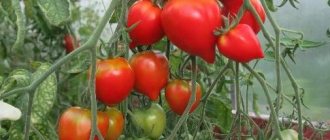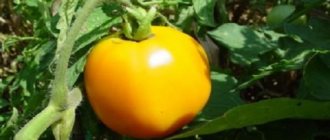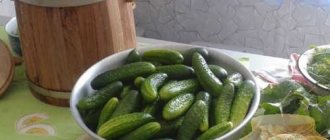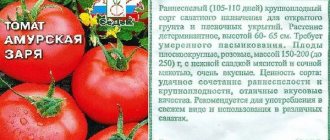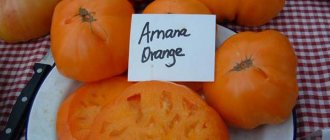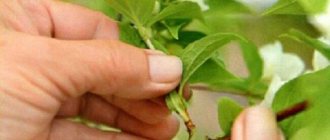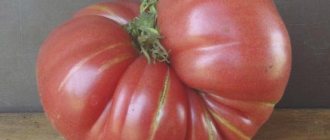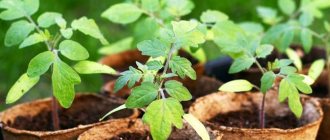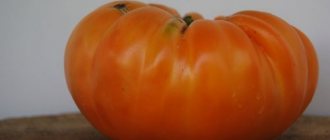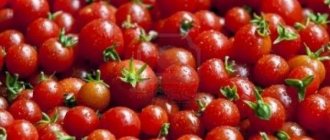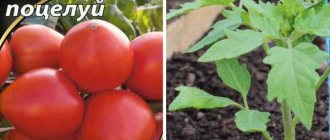Vegetable growing » Tomatoes
0
1668
Article rating
Kira Stoletova
Each vegetable crop in a garden or summer cottage serves to satisfy certain desires of the owner: to surprise with a new original variety, to spend less time and effort on caring for plants. Tomato Legend Tarasenko is the best choice for those gardeners who want to grow good tomatoes for harvesting for the winter.
Characteristics of tomatoes variety Legend Tarasenko
Characteristics of the variety and a description of the features of tomato care will help you make a choice and properly prepare for the new garden season. Creating favorable conditions for a given variety means ensuring an excellent harvest.
Characteristics and description of the variety
Feodosius Makarovich Tarasenko is a physics teacher at school, an amateur gardener, and the creator of more than 50 types of tomato crops. One of its earliest and best varieties is Legend Tarasenko (Multiflora), intended for cultivation in open ground.
Distinctive features
The bush is indeterminate, up to 2 m high, 5-7 fruiting clusters are formed on the stem. The cluster is complex, each bears 20-25 fruits.
The ripening period is average, from the moment of emergence of seedlings to full ripening, 115-120 days pass. It is recommended for cultivation in open ground, but in regions with short summers it is planted in a greenhouse. Fruiting is extended, until frost.
The productivity is high, up to 20 kg of vegetables are harvested from 1 bush, provided that 3 seedlings are planted per 1 sq. m. m.
Resistance to diseases is high, immune to most dangerous diseases.
The crop requires regular pinching and staking of tall bushes, otherwise the heavy fruit-bearing branches will spread along the ground.
Fruit characteristics
Average weight - 85-110 g, cylindrical shape in the form of an elongated cream, bright scarlet color. The taste is pleasant, sweet, without sourness, the flesh is juicy and meaty. The skin is dense and does not crack.
The purpose in cooking is universal; it is used fresh, for preparations for the winter and for processing into tomato products.
Ripe vegetables are stored for a long time and can withstand long-term transportation, maintaining their marketable appearance.
The photo shows Legend Tarasenko tomatoes.
Features of cultivation, planting and care
We recommend sowing the seeds of this tomato for seedlings 60-65 days before the intended planting in the ground. Seedlings dive at the stage of two true leaves. When planting seedlings in a permanent place per 1 sq. It is recommended to place up to 3 plants per meter of land; when forming into 1 stem - up to 4.
Further care for tomatoes consists of timely watering, fertilizing with complex mineral fertilizer, pinching and preventive measures to protect against diseases and pests.
A site about tomato varieties with truthful reviews from gardeners - Tomatland.
Video: how to shape a tomato
If you grew Legend Tarasenko tomatoes, please write whether you liked them or not. What was the yield and taste of the fruit under your conditions? Will you grow them again? Briefly describe the advantages and disadvantages (pros and cons) of this tomato in your opinion. If possible, attach to your review a photo of the entire bush as a whole or individual fruits you grew. Thank you!
This is a natural variety of tomato. Therefore, we recommend taking seeds from a ripe fruit and using them for planting in subsequent seasons.
Your reviews of the Legend Tarasenko tomato and additions to the description will help many gardeners evaluate this variety and decide whether it is worth planting or not.
You can see other interesting varieties and hybrids of tomatoes with photos, descriptions and reviews in our Tomato Catalog. Enjoy watching.
How to grow seedlings
Preparing seeds for sowing begins 2 months before planting seedlings in the ground. Late February-early March.
Seed preparation
First, the seeds are immersed in a saline solution for 10 minutes.
This is how they check the empty ones: those that float up are not suitable for landing. Disinfect planting material by immersing it in a weak solution of potassium permanganate for 20 minutes. Afterwards, the grains are washed with running water and dried.
Heat treatment for 25 minutes makes the seeds stronger and more elastic, which will help with their germination: the seeds are heated in hot water at a temperature of 52 degrees, having previously wrapped them in gauze. Immediately after this, rinse in cold water for 2 minutes.
During heat treatment, about 30% of seeds may lose their viability. But this is not scary: only non-viable specimens die.
To improve germination, seed material is placed in a growth stimulator for 12 hours. As soon as the seeds swell slightly, they can be sown in the ground.
Container and soil
The soil is prepared from garden soil and humus in equal quantities. For looseness, add a little sawdust or peat - the soil becomes airy and allows moisture to pass through well.
The prepared mixture is laid out halfway in the planting containers, so that later, as the seedlings grow, the remaining soil can be added to the containers. This technique helps to obtain nutrients in the required quantities.
You can plant in a common wooden box and disposable containers, for example, in plastic or peat cups.
Reference! While the sprouts are in peat cups, the young roots are generously supplied with oxygen, since the material is porous and allows oxygen to pass through well.
Sowing
The seeds are sown in prepared containers to a depth of 1.5-2 cm. Sprinkle peat on top and lightly moisten with a spray bottle. Then the containers are covered with film to create a greenhouse effect.
Reference! If the planting material is sown shallowly, it will germinate along with the shell, which will cause further slow growth.
The sown containers are left in a bright and warm room at a temperature of at least 24 C. If the temperature is maintained at a constant temperature, the first shoots can be seen after 7 days.
Growing and caring for seedlings
After the first shoots appear, the film is removed and the containers are moved to a sunny windowsill.
Reference! To avoid serious burns, seedlings should not be exposed to direct sunlight.
There should be at least 14 hours of daylight.
If there is a lack of natural light, add phytolamps. After all seeds have germinated, the temperature in the room where the seedlings are located is reduced to 15 C for 1 week. This is how the young bushes are hardened and the immune system is strengthened. After 7 days, the seedlings are transferred to a warmer place with an air temperature of at least 20 C.
Water with warm, settled water as the top layer of soil dries out. Water with a shallow watering can or tablespoon along the edge of the containers, without flooding the soil, otherwise the young roots may rot.
After 2-3 true leaves appear, the seedlings are planted, planted in separate containers. When growing in peat cups, seedlings do not need to be picked.
2 weeks before planting in the ground, the seedlings are hardened off. To do this, it is taken out into the open air for 1 hour, gradually increasing the time spent on the street to 13 hours. The night temperature of the room where the seedlings are brought is reduced to 12 C.
Transplanting seedlings into the ground
When planting strong seedlings of Legend Tarasenko in the ground, you should know that the root system of these tomatoes is very powerful. It penetrates deep into the soil substrate, becoming firmly established there. Therefore, transplanting young seedlings requires careful conditions and constant care of the plant.
The plant is transplanted from a container into open ground in late May - early June. It is at this moment that the soil warms up to the required +15 C, and there is no longer any danger of return frosts. In addition, the Legend Tarasenko tomato bushes are already fully formed and have one ovary cluster.
Landing Features:
- The soil for growing in open areas should be prepared 1-1.5 months in advance or even in early autumn. Legend tomatoes are usually rooted by digging holes. Each depression in the soil should not be less than 50 cm wide and 40 cm deep.
- Humus and wood ash are added to the bottom of the pit. Next, mineral fertilizers – nitroammophoska – are added. All this is mixed with soil dug in advance. In this form, the recesses are left to wait until the planting work begins.
- Seedlings should be planted when they are about 2 months old. In order for the bushes to develop well and grow actively without interfering with each other, leave about 1 meter between neighboring bushes. And the rows are separated from each other by 1.5 meters.
- 2-3 seedlings are placed in each hole. This is necessary for the plants to hold on to each other. After planting, young shoots are irrigated with a solution of diluted manganese at a dosage of 3 grams. the drug per bucket of water (10 l).
Further care consists of watering and fertilizing.
How to grow tomatoes
After 2 months, the seedlings are ready for transplanting into the ground. By this time, the root system is sufficiently developed and penetrates deep into the soil. In addition, the bushes are fully formed and have one ovary.
Landing
Seedlings are planted in the ground in late May-early June, when the ground warms up to 15 C. The soil for tomatoes is prepared a month before planting, it is dug up and weeds with roots are removed. Due to the developed roots, the holes are made at least 35 cm deep, adding a little humus, wood ash and mineral fertilizer to the bottom.
Planting pattern: 80 cm – distance between seedlings, 90-110 cm – between rows. 2-3 seedlings are placed in one hole so that the plants stick to each other. Spray with a weak solution of potassium permanganate.
Reference! It is best to replant on a cloudy day or in the evening. This method promotes faster adaptation of seedlings to street conditions.
After transplanting, the tomatoes are watered abundantly and left for 10-12 days for them to take root in the ground on their own.
Further care for Legend Tarasenko
Regular watering is established once a week. Water generously, at the root, with at least 7 liters of warm, settled water per bush until the fruit begins to form. Despite the large amount of moisture consumed, the beds should not be allowed to become waterlogged. This can lead to the development of fungal diseases. Also, increased humidity can affect the taste of vegetables.
Reference! Water in the morning or evening to avoid burning the green mass if moisture gets on the leaves.
After each watering, loosening is carried out, removing weeds with roots.
This not only improves the penetration of oxygen into the soil, but also serves as a necessary preventive measure in pest control. To retain moisture in the beds, they are mulched with straw or weeds. When weeds rot, they release beneficial substances, thereby feeding the roots of the plants. The first time is fed 14 days after transplanting into the ground with a full range of mineral fertilizers or organic matter. As organic matter, mullein infusion or bird droppings are used in a ratio of 1:15.
The second time is fed during the formation of the ovaries. The second feeding is no different from the first; organic matter or mineral fertilizers are used.
The third feeding is during fruiting. Potassium fertilizers are added to the mineral solution - they contribute to the rapid filling of fruits.
Features of cultivation and possible difficulties
Due to their high growth and heavy load on the stem, tall plants require mandatory staking. Not only the stem is tied up, but also the fruit-bearing branches, since they cannot withstand the weight of ripe vegetables and bend to the ground.
Constant contact with wet beds leads to rotting of the fruits. For fixation, a metal or wooden support is installed next to each bush.
Stepchildren are pruned regularly by removing unnecessary shoots. It is recommended to leave 2-3 cm so that new stepsons do not grow from the shoot.
For maximum yield, the crop is formed into 1 or 2 stems. It is under this condition that the greatest return is possible.
Diseases and pests
The culture is resistant to many diseases, but neighboring plants can infect it.
You should not plant crops belonging to the nightshade family next to tomatoes. Among the infections, they especially include: tobacco mosaic, brown spot and gray rot. Tobacco mosaic has a viral etiology and is characterized by white stains on a discolored leaf, to which yellow spots are then added. It is possible to cure the plant only in the first stages by replacing the top layer of soil and treating it with a milk solution (1 liter of milk per 10 liters of boiled water) with the addition of a few drops of iodine. Be sure to treat with any fungicide.
Brown spot and gray mold are fungal diseases. Their prevention is moderate watering and regular loosening. Fungal spores develop at high humidity and high temperatures, so it is necessary to monitor the condition of the beds. Antifungal insecticides such as Fitosporin and Bordeaux mixture help in the fight against these diseases.
Reference! The use of chemicals is possible only before the formation of the ovaries.
Dangerous pests include mole crickets, Colorado potato beetles, whiteflies and aphids. For whiteflies and aphids, use soap solutions with the addition of ash. The Colorado potato beetle is collected by hand, and the mole cricket is scared away from the beds by planting sharp-smelling plants next to the tomatoes.
Preventive measures are the most effective in the fight against pests. Find the insect in time and stop its reproduction. Daily inspection of plantings is necessary.
Characteristics of the variety
Legend Tarasenko is a variety of mid-season tomatoes, grown in greenhouses and in open ground.
The variety is indeterminate and requires pinching and tying. Tomatoes bear fruit until frost.
The name of the variety indicates its origin. A variety of tomatoes was bred by Ukrainian amateur breeder F.M. Tarasenko from the Sumy region of Ukraine. Tarasenko preferred tall tomatoes. He created more than 50 varieties and hybrids, including those popular among gardeners:
- Hybrids F1 Tarasenko No. 1, No. 2, No. 3;
- Polesie Giant Tarasenko;
- Anniversary Tarasenko.
Tarasenko tomatoes are successfully grown in the southern regions of Russia, in the Middle Zone, and in Western Siberia. There are positive responses from gardeners in Karelia and the Arkhangelsk region.
Description of the bush
A tomato bush reaches 1.5-1.8 m in open ground, more than 2 m in a greenhouse. Experts recommend forming a plant with 2-3 stems, then you can get the greatest return. As it grows, it is necessary to remove excess leaves. When taking stepsons, vegetable growers recommend cutting off the shoots, leaving 2-3 cm, so that new stepsons do not grow from the dormant bud.
The bush must be tied up due to its high growth and heavy load on the stem during fruit set and ripening of the crop. 5-7 tassels are tied on each stem.
Description of fruits
Legend Tarasenko tomatoes have an unusual fruit shape - cylindrical with a spout, reminiscent of an inverted budenovka. The brush is complex, 15-25 fruits are set, according to some vegetable growers - 30-40. Each tomato weighs 80-110 grams, and a ripe bunch can weigh 3-3.5 kg. Thus, you can get a harvest of 20-25 kg from the bush.
The fruits are distinguished by their ability to be stored for a long time
The fruits are bright red and dense. The skin is not prone to cracking. If the necessary conditions are met, tomatoes can be stored for a long time (until the New Year holidays) and transported without loss. Vegetable growers note the excellent taste of Legend tomatoes. The variety is indispensable for making pickles and preparations for the winter, and for eating raw.
The nuances of breeding in open ground and in a greenhouse
Greenhouse plants grow up to 2.5 m in height, so they are pinched to limit their growth point.
Although the variety is recommended for open ground in cold regions, it is also successfully grown in closed structures. Productivity and taste do not become worse because of this. Greenhouses must be regularly ventilated to avoid the spread of fungal spores.
In warm regions, the tomato is formed into 1 stem, in cold areas - into 2 stems.
In order not to overload the bush, the lower leaves of the plants are removed down to the third pair from the bottom.
Growing seedlings
To get good strong tomato seedlings Legend Tarasenko, the seeds should first be planted as seedlings. This should be done in winter or at the very beginning of spring, so that at the time of planting the sprouts are already large enough and can easily withstand the process of moving to a new place of residence.
Seedlings are prepared in advance before planting. Preparatory work begins in early March or at the end of February:
- The seeds are thoroughly tested by immersion in a 5% sodium chloride solution.
- Seedlings are disinfected in a 1% solution of potassium permanganate; the shade of the essence should be slightly crimson. Disinfection time – 15 minutes.
- Next, the seeds are immersed in a mixture of microelements for 12 hours.
- It is recommended to carry out heat treatment - at 52 C the seeds are calcined for 25 minutes. After this, they are soaked in Epin mineral fertilizers for 18 hours.
Once the Legend seeds have swelled slightly, they can be planted in prepared containers. In containers, the soil must also be prepared. For good growth, you need to take soil in equal proportions - turf and together with humus. In order for the soil to be loose, airy and well-permeable to moisture, it should be flavored with sawdust or peat.
Sowing of prepared seeds of Legend Tarasenko is carried out on March 14-21. It is recommended to sow swollen seedlings in flowerpots not exceeding 10 cm. Planting material is planted to a depth of 0.5-1 cm, lightly sprinkled with soil. Cover the top with film, glass or a plastic bag. It is important to create greenhouse conditions for high-quality germination.
The speed of germination depends on the internal climate.
Plantings are placed in a sunny, warm place, where the temperature is up to +25 C. If you keep the conditions for germination in this range, the first shoots will appear in 7-10 days. After the first timid leaves appear, it is recommended to add additional light to the plantings. After all, tomatoes require a lot of light, which is not enough at the end of March.
The emerging Legend shoots must undergo hardening. They are moved to a cooler but brighter room. They must be kept at a temperature of +12..+16 C for at least 7 days. Then they are transferred to a warmer room, where the air temperature is constant - +18 C.
While the Legend seedlings are gaining strength and growing, they are watered with settled water at room temperature. Watering should be done as the top soil layer dries out. Flooding is not recommended; it can cause root rot or disease.
Harvesting and application
Fruit ripening is uniform, fan clusters ripen entirely, which does not make it difficult to collect ripe vegetables. Fruiting is extended, in greenhouses the fruits ripen until the first frost.
The purpose of ripe vegetables is universal: they are eaten fresh, they perfectly complement hot and vegetable dishes, for example, stews and purees. Small fruits are used for whole-fruit canning, larger vegetables are used for pickling and marinades. Also used for making juice, lecho, ketchup and adjika.
Ripe vegetables can be stored for a long time and can withstand long-term transportation.
Description and characteristics of the tomato variety Legend Tarasenko, reviews, photos
Mid-season, indeterminate, high-yielding, reliable tomato variety. Recommended for growing in greenhouses.
The second name of the variety is Nadiya, this is the last variety created by Feodosia Makarovich Tarasenko.
A bush up to 2 meters high, requiring tying to a support and pinching. The best result was obtained when forming a plant with 1 or 2 stems.
The brushes of this variety are complex, with 10-20 ovaries in each.
Basic qualities of fruits
photo by Valentina Redko
The fruits are elongated cream with a drawn-out spout, smooth, glossy, red in color at maturity, weighing 80-100 grams, excellent taste. These tomatoes are great for pickling and canning, and they are also tasty in fresh salads.
Advantages of the variety : high yield, excellent commercial quality of the fruit.
Tomato yield Legend Tarasenko : up to 5 kg of fruit from 1 plant (subject to agricultural practices, watering and fertilizing).
Advantages and disadvantages of the variety
The legend Tarasenko has a lot of positive qualities:
- ease of care;
- excellent yield;
- resistance to diseases of the nightshade family;
- adaptation to climatic conditions;
- survival rate in all regions;
- excellent taste of fruits;
- unusual shape;
- versatility in cooking;
- excellent presentation;
- long-term storage;
- long transportations.
The only negative properties include the need to tie up tall bushes and systematically plant the crop.
Description and advantages of the variety
Legend Tarasenko is a variety of tomatoes bred by the Ukrainian school physics teacher F.M. Tarasenko. In addition to the Legend, the amateur gardener bred more than 50 varieties of tomatoes. Legend Tarasenko is considered the best of the entire selection. Tomato - stretches up to 2 meters, is considered a tall representative of the tomato family. As it grows, the plant should be tied to a support or a special trellis should be erected. If you do not build a support, the bush will begin to spread along the ground.
The variety is very fertile, all ovaries are pollinated, develop safely and form fan-shaped clusters. As they grow, side shoots need to be removed so that they do not burden the tomato and draw on excess nutritious juices. If you leave the sprouts from the internal sinuses, the bush will stop bearing fruit. He will switch to forcing out young shoots. Therefore, it is recommended to remove them at the initial stage of development. In this case, you should leave the stump from the stepson 2-3 cm from the base. This is necessary so that the dormant bud does not shoot again.
The only moment favorable for the development of the plant is that as the young seedling grows, it needs to be formed so that two stems are formed. It is this structure of the bush that will allow you to get the largest possible harvest.
Legend Tarasenko is a mid-season variety.
The ovary can have from 20 to 30 peduncles, which all successfully form into tomatoes. Each of the fruits is an elongated cream with a slightly elongated, elongated nose. When ripe, vegetables have a bright scarlet hue and are smooth to the touch with a glossy sheen. Each Legend tomato weighs up to 100 grams. It has distinctive taste, with a pleasant aftertaste. The fruit pulp is dense and does not fall apart. They are great for winter pickling, as well as for canning and salads in the summer.
The advantages of this variety are:
- High yield, allowing you to collect several kilograms of net weight from the bush.
- Excellent appearance, allowing the variety to be highly valued as a marketable product.
- Good transportability - due to their dense structure, vegetables can withstand long-term transportation.
Thus, the Legend Tarasenko tomato is very popular among those who like to grow tomatoes. Having tried to grow this miracle of modern selection, the need for other varieties of tomatoes disappears by itself.
Farmer reviews
The legendary tomato, created by a Ukrainian amateur breeder, has many fans. Here are the opinions of some gardeners:
Olga, Brest: “The clusters contain a large number of fruits, suitable for both canned food and salads. The taste is excellent, sweet, slightly sour. I grow it in a greenhouse, the stem is powerful, but I can’t do without a garter.”
Tamara, Astrakhan region: “I grow the plant in 2 trunks, I have been planting this species for more than 3 years. The vegetables are delicious, just what I need. There is always enough to eat in the summer and to prepare for the winter. I recommend it to everyone."
Description
The plant is indeterminate, up to 1.5 m high in beds and up to 2.5 m in greenhouses. It has a powerful root system that goes to great depths. The fruits form complex fan-type clusters. One brush can contain up to 30 tomatoes.
The fruits are characterized by the following:
- The shape is elongated, oval, plum-shaped, with a pointed tip.
- Average weight - 100-110g.
- The taste is pleasant, without sourness, the flesh is juicy and meaty.
- The color when ripe is red.
- The skin is shiny, dense, and has no tendency to crack.
The ripening of fruits in the clusters is almost simultaneous; the first fruits turn red 110-120 days after germination. Fruiting is extended, sometimes (in greenhouses) continues until frost.
Due to their pleasant taste, the fruits are widely used in cooking. However, despite its universal purpose, the multiflora legend tomato, according to reviews, is considered an ideal pickling variety, since when whole fruits are processed, they do not crack.

